 Image 1 of 6
Image 1 of 6

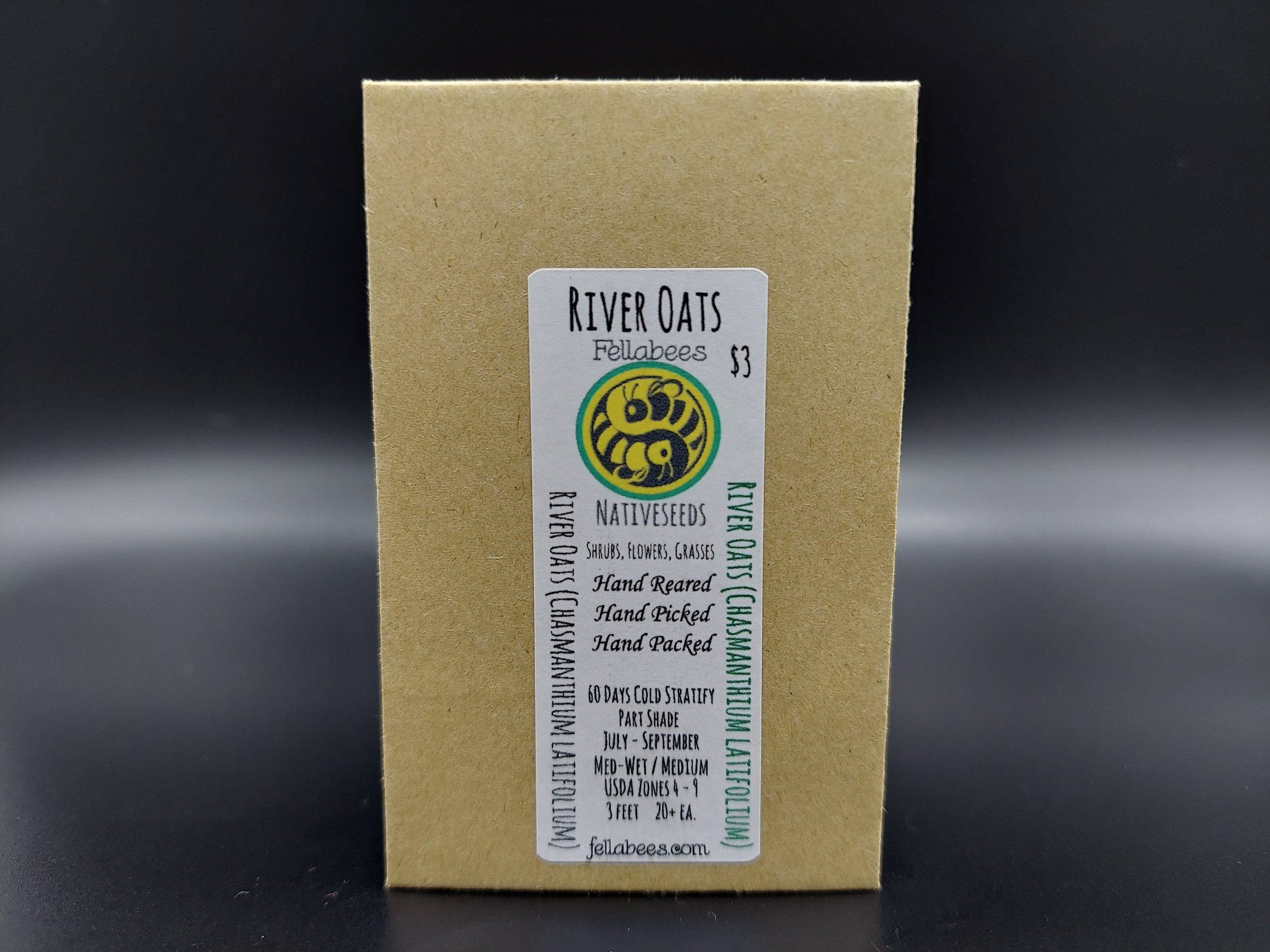 Image 2 of 6
Image 2 of 6

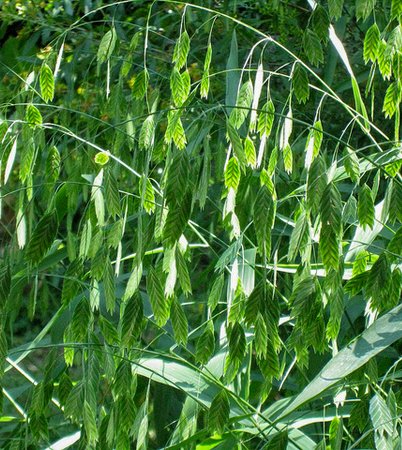 Image 3 of 6
Image 3 of 6

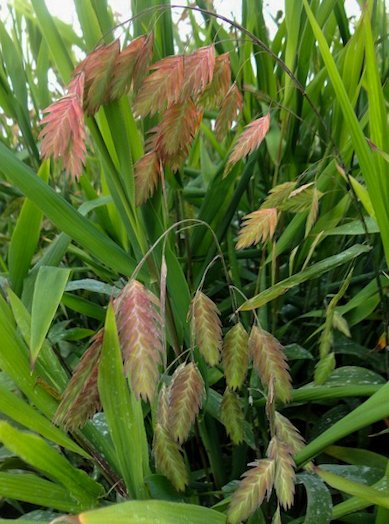 Image 4 of 6
Image 4 of 6

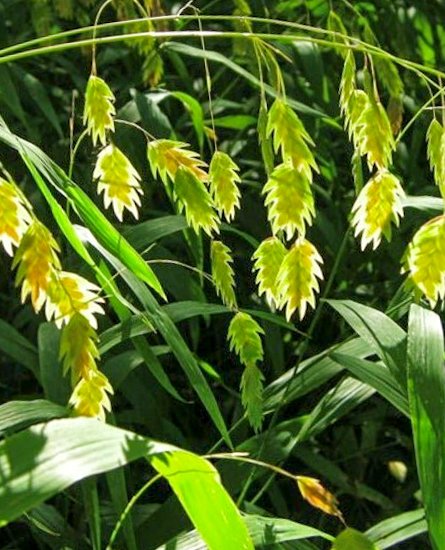 Image 5 of 6
Image 5 of 6

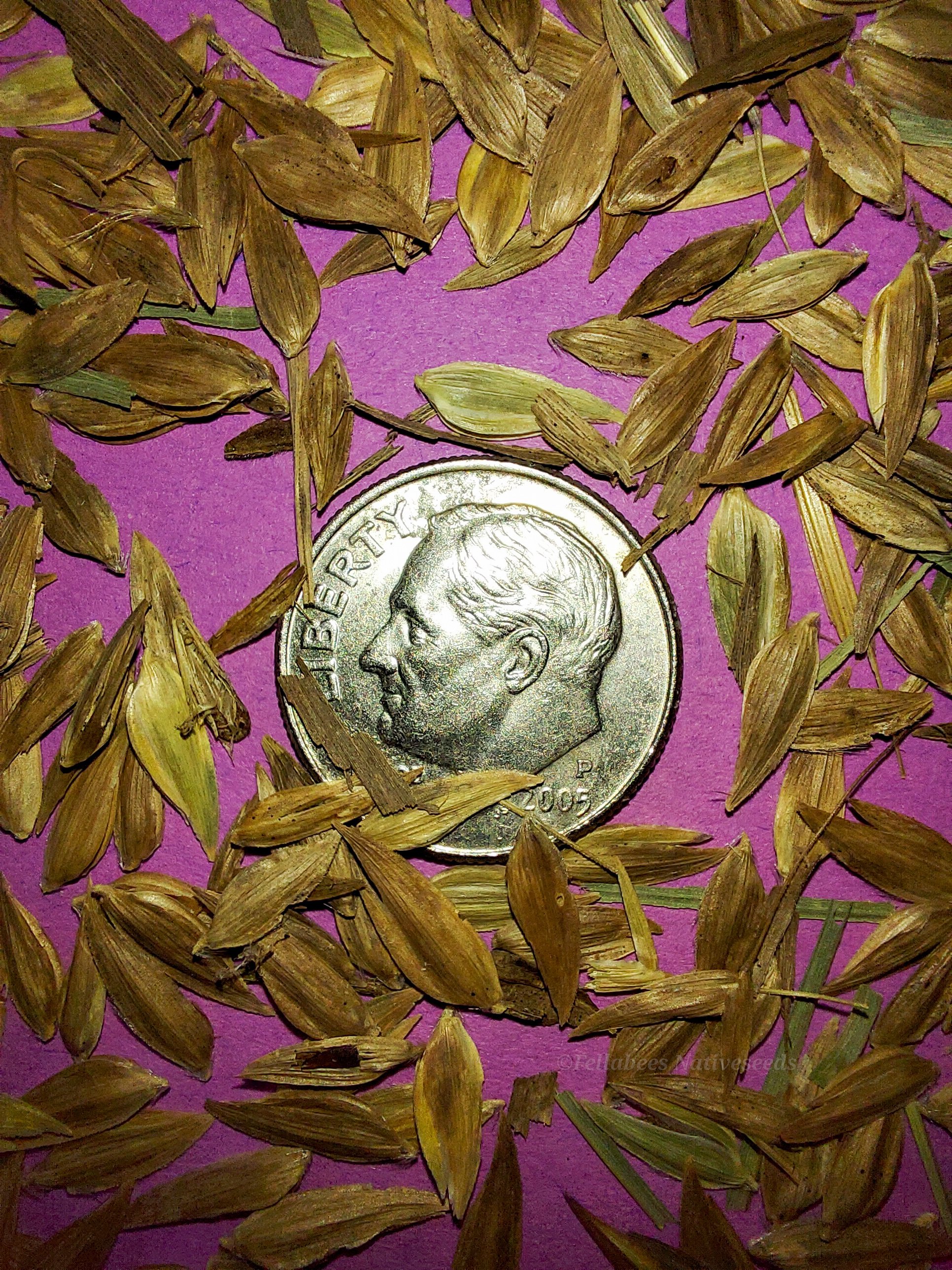 Image 6 of 6
Image 6 of 6







River Oats (Chasmanthium latifolium)
River Oats (Chasmanthium latifolium)
Chasmanthium latifolium is the scientific name for the native grass species more commonly known as River Oats, Fish-On-A-Fishing-Pole, Northern Wood-Oats, Inland Sea Sats, or Northern Sea Oats.
River Oats is endemic to the Central and Eastern United States, Manitoba, and northeastern Mexico, it found growing as far north as Wisconsin, Pennsylvania and Michigan, where it is a threatened species.
River Oats is a cool-season, rhizomatous, perennial grass, adorned with culms about 3 feet tall. The inflorescence is an open, nodding panicle of laterally flattened spikelets. The plant typically grows in wooded areas and riparian zones (an interface between land and a river or land and streams).
River Oats is very popular with humans, and is used in landscaping throughout North America, where it is noted as a relatively rare native grass that thrives in partial shade, performing well in various conditions such as acidic sands, loams, and clays.
River Oats is a larval host plant for the Northern Pearly-Eye Butterfly, and its seeds are an excellent food for birds and mammals, while being resistant to rabbits and deer. It is also one of the host plants for the caterpillars of the Pepper and Salt Skipper, Bell's Roadside Skipper, and the Bronzed Roadside Skipper Butterflies!
This plant is listed as present but rare in several counties of the states of Arizona, New Mexico, Iowa, Michigan, Pennsylvania, Massachusetts, New Jersey, and as extirpated in several counties of the states of Maryland and Delaware.
Plant Details
USDA Zones: 4-9
Germination Needs: 60 Days Cold Stratification
Life Cycle: Perennial
Sun Exposure: Partial
Soil Moisture: Medium-Wet, Medium
Plant Spacing: 1-2 feet
Height: 3 feet
Bloom time: July, August, September
Advantages :
Pollinator Favorite: Skipper Butterflies!
Bird Favorite: seeds, insects, fruit, nectar, nesting, perchs.
Deer Resistant: Yes
Native to, or present in: Wisconsin, Iowa, Michigan, Illinois, Indiana, Ohio, Pennsylvania, Massachusetts, New Jersey, Delaware, Maryland, West Virginia, Virginia, Kentucky, Tennessee, North Carolina, South Carolina, Georgia, Florida, Alabama, Mississippi, Louisiana, Arkansas, Missouri, Nebraska, Kansas, Oklahoma, Texas, New Mexico, and Arizona.
.
.
Packet quantities:
We pride ourselves on ethical, hands on, ecological management, using no mechanical or chemical methods whatsoever.
All of our native seed is hand reared, hand picked, and hand packed from native prairies under our exclusive management, never breaking chain of custody from the field until it is sent to you. Each packet is hand prepared for shipment by us, directly.
Small seed species will contain greater than 20-25 seed
Large seed species will contain greater than 10-15 seed
It is our mission to spread the wealth of native plant and pollinator ecological sustainability, and educate back yard gardeners as well as corporate and government entities in how to germinate, grow, and benefit from native synergies.
Thank you for your support, it is because of you, that we can grow together to do, what we do.🐛🦋🐝🐞🌾🌱🌼🧡
River Oats (Chasmanthium latifolium)
Chasmanthium latifolium is the scientific name for the native grass species more commonly known as River Oats, Fish-On-A-Fishing-Pole, Northern Wood-Oats, Inland Sea Sats, or Northern Sea Oats.
River Oats is endemic to the Central and Eastern United States, Manitoba, and northeastern Mexico, it found growing as far north as Wisconsin, Pennsylvania and Michigan, where it is a threatened species.
River Oats is a cool-season, rhizomatous, perennial grass, adorned with culms about 3 feet tall. The inflorescence is an open, nodding panicle of laterally flattened spikelets. The plant typically grows in wooded areas and riparian zones (an interface between land and a river or land and streams).
River Oats is very popular with humans, and is used in landscaping throughout North America, where it is noted as a relatively rare native grass that thrives in partial shade, performing well in various conditions such as acidic sands, loams, and clays.
River Oats is a larval host plant for the Northern Pearly-Eye Butterfly, and its seeds are an excellent food for birds and mammals, while being resistant to rabbits and deer. It is also one of the host plants for the caterpillars of the Pepper and Salt Skipper, Bell's Roadside Skipper, and the Bronzed Roadside Skipper Butterflies!
This plant is listed as present but rare in several counties of the states of Arizona, New Mexico, Iowa, Michigan, Pennsylvania, Massachusetts, New Jersey, and as extirpated in several counties of the states of Maryland and Delaware.
Plant Details
USDA Zones: 4-9
Germination Needs: 60 Days Cold Stratification
Life Cycle: Perennial
Sun Exposure: Partial
Soil Moisture: Medium-Wet, Medium
Plant Spacing: 1-2 feet
Height: 3 feet
Bloom time: July, August, September
Advantages :
Pollinator Favorite: Skipper Butterflies!
Bird Favorite: seeds, insects, fruit, nectar, nesting, perchs.
Deer Resistant: Yes
Native to, or present in: Wisconsin, Iowa, Michigan, Illinois, Indiana, Ohio, Pennsylvania, Massachusetts, New Jersey, Delaware, Maryland, West Virginia, Virginia, Kentucky, Tennessee, North Carolina, South Carolina, Georgia, Florida, Alabama, Mississippi, Louisiana, Arkansas, Missouri, Nebraska, Kansas, Oklahoma, Texas, New Mexico, and Arizona.
.
.
Packet quantities:
We pride ourselves on ethical, hands on, ecological management, using no mechanical or chemical methods whatsoever.
All of our native seed is hand reared, hand picked, and hand packed from native prairies under our exclusive management, never breaking chain of custody from the field until it is sent to you. Each packet is hand prepared for shipment by us, directly.
Small seed species will contain greater than 20-25 seed
Large seed species will contain greater than 10-15 seed
It is our mission to spread the wealth of native plant and pollinator ecological sustainability, and educate back yard gardeners as well as corporate and government entities in how to germinate, grow, and benefit from native synergies.
Thank you for your support, it is because of you, that we can grow together to do, what we do.🐛🦋🐝🐞🌾🌱🌼🧡
River Oats (Chasmanthium latifolium)
Chasmanthium latifolium is the scientific name for the native grass species more commonly known as River Oats, Fish-On-A-Fishing-Pole, Northern Wood-Oats, Inland Sea Sats, or Northern Sea Oats.
River Oats is endemic to the Central and Eastern United States, Manitoba, and northeastern Mexico, it found growing as far north as Wisconsin, Pennsylvania and Michigan, where it is a threatened species.
River Oats is a cool-season, rhizomatous, perennial grass, adorned with culms about 3 feet tall. The inflorescence is an open, nodding panicle of laterally flattened spikelets. The plant typically grows in wooded areas and riparian zones (an interface between land and a river or land and streams).
River Oats is very popular with humans, and is used in landscaping throughout North America, where it is noted as a relatively rare native grass that thrives in partial shade, performing well in various conditions such as acidic sands, loams, and clays.
River Oats is a larval host plant for the Northern Pearly-Eye Butterfly, and its seeds are an excellent food for birds and mammals, while being resistant to rabbits and deer. It is also one of the host plants for the caterpillars of the Pepper and Salt Skipper, Bell's Roadside Skipper, and the Bronzed Roadside Skipper Butterflies!
This plant is listed as present but rare in several counties of the states of Arizona, New Mexico, Iowa, Michigan, Pennsylvania, Massachusetts, New Jersey, and as extirpated in several counties of the states of Maryland and Delaware.
Plant Details
USDA Zones: 4-9
Germination Needs: 60 Days Cold Stratification
Life Cycle: Perennial
Sun Exposure: Partial
Soil Moisture: Medium-Wet, Medium
Plant Spacing: 1-2 feet
Height: 3 feet
Bloom time: July, August, September
Advantages :
Pollinator Favorite: Skipper Butterflies!
Bird Favorite: seeds, insects, fruit, nectar, nesting, perchs.
Deer Resistant: Yes
Native to, or present in: Wisconsin, Iowa, Michigan, Illinois, Indiana, Ohio, Pennsylvania, Massachusetts, New Jersey, Delaware, Maryland, West Virginia, Virginia, Kentucky, Tennessee, North Carolina, South Carolina, Georgia, Florida, Alabama, Mississippi, Louisiana, Arkansas, Missouri, Nebraska, Kansas, Oklahoma, Texas, New Mexico, and Arizona.
.
.
Packet quantities:
We pride ourselves on ethical, hands on, ecological management, using no mechanical or chemical methods whatsoever.
All of our native seed is hand reared, hand picked, and hand packed from native prairies under our exclusive management, never breaking chain of custody from the field until it is sent to you. Each packet is hand prepared for shipment by us, directly.
Small seed species will contain greater than 20-25 seed
Large seed species will contain greater than 10-15 seed
It is our mission to spread the wealth of native plant and pollinator ecological sustainability, and educate back yard gardeners as well as corporate and government entities in how to germinate, grow, and benefit from native synergies.
Thank you for your support, it is because of you, that we can grow together to do, what we do.🐛🦋🐝🐞🌾🌱🌼🧡
